Bevy of Kids Games Reviews and Game Giveaway!

After a couple week break — including Fall Break for our kids from school — it’s time to dive back into some game reviews.
And what better way to catch up on reviews than sharing our thoughts on a bunch of kids games!
Over the coming 7 days we’re reviewing 7 new board games and card games your kids may love.
Since kids games have very simple rules, each review will be a shorter than our typical reviews. As such, we’re also going to review a couple games at a time. And we’ll end with a game giveaway!
We’re starting off with 3 games that can help your kids with math:
- Monster Crunch: The Breakfast Battle Game
- This Game Goes to Eleven
- Make 7
Monster Crunch: The Breakfast Battle Game
Monster Crunch: The Breakfast Battle Game may look like General Mills just got into the board game business, but that’s only because the game box looks just like a box of cereal!
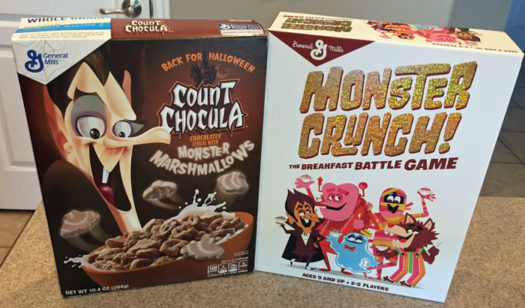
In Monster Crunch, by Big G Creative, 2-5 players compete to see who can eat the most cereal. Ok, you’re not really eating cereal. Rather players are trying to end the game with more cereal cards collected than the other players.
In the game, each player gets their own deck of 36 cereal cards (Count Chocula, Franken Berry, Boo Berry, Fruit Brute, or Fruity Yummy Mummy), their matching cereal bowl board, and 2 special powers related to their chosen cereal.
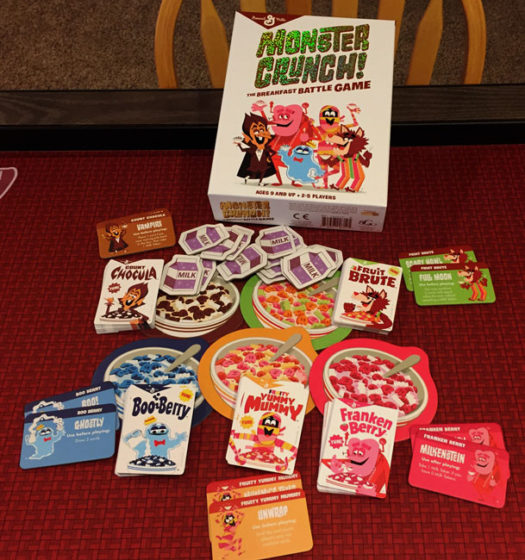
The game is played over 3 Hands each comprised of multiple Rounds. Players shuffle their deck of cards and draw 12 cards to form their first Hand. In turn, players choose a card from their hand to play to their bowl. The next player must play a card to their bowl that’s either equal to or higher than the value played by the previous player. If a player can’t play a card or chooses not to, they pass and put the cards from their bowl into their scoring pile. They’re out of the rest of the round. When passing, a player also takes a Milk token.
A player can also play extra cards from their hand during a round by playing Milk tokens. For each extra card played on a turn, the player returns a Milk token. The only catch is that the extra cards must either match in value (3, 3, 3, etc.) or be consecutive (5, 6, 7, etc.). The value of these played cards is the new value that the next player must either match or exceed to stay in the round. For example, if the player plays 3 cards of value 4 each, the next player must play 12 or higher into their bowl.
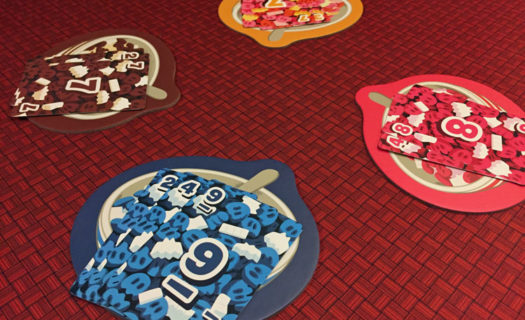
Play continues until there’s only one player left in the round. That player adds the cards from their bowl to their scoring pile (but doesn’t get a Milk token) and then begins another round by playing a card from their hand.
When any player plays the last card from their hand, the Hand ends immediately and any player with cards left in their hand sets them aside (don’t get to score them). After the third (last) Hand is complete, players count the number of cards in their score pile and that’s their final score. The player with the most wins!
Monster Crunch is a fun kids game.
It’s a simple game of playing cards to get rid of the most of your cards. And kids will easily understand their options of playing cards of the same or higher value.
And they’ll learn that Passing on a turn isn’t always a bad thing. Because when you Pass, you also get a Milk token – which will let you play combined sets of cards later which may be a better way of getting a lot of cards into your bowl and ending the hand before other players. This way, they won’t get to score those cards at the end of the game.
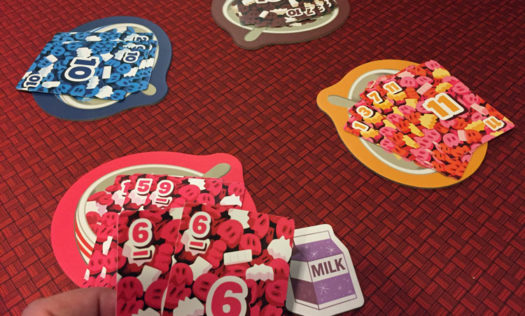
In addition, each player has special powers that can each be used once during the game. Each power adds a twist to the game in unique ways. As examples, one of Count Chocula’s powers is that for the rest of the round cards being played must be of a lower value rather than a higher value. Boo Berry has a power that doubles the value of a played card. And Franken Berry can pay a Milk token to combine any two cards for a turn.
Monster Crunch is also a fun kids game because the scores will typically be close. Players will be able to play most of their cards and thus scores will typically end in the 26 to 34 range. It’s easy for kids to learn and they’ll love switching up the type of cereal they’re playing each game.
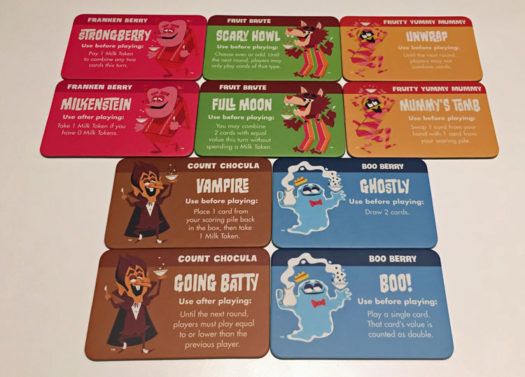
This Game Goes to Eleven
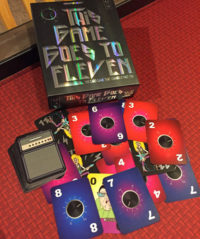
This Game Goes to Eleven is a simple card game by Gamewright for 2-6 players. In the game players try to end up with the least amount of cards.
The game consists of a deck of 72 cards numbered 0 to 11. Each player begins with 3 cards and on their turn will play one card from their hand and then draw a new card. When playing a card, the player announces the new total of the pile by adding the pile’s current value with the value of the card they played.
If the value is less than 11, play continues with the next player. If the value of the pile is exactly 11, the player who played the card to reach 11 takes the pile of cards and gives it to another player to add to their score pile. If the value is greater than 11, the player who just played a card must take the pile of cards and add it to their own score pile.
Players also have the option of creating more than one pile of cards. Players cannot play the same number card on top of one another. Instead, a player may start a new pile by playing a card of matching value to what’s on the top of a pile. For example, if there’s a 3 on the top of the pile, a player may play a 3 from their hand as a new pile.
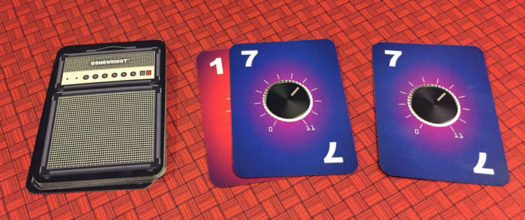
Players can also play the 11 value card on a pile to immediately complete the pile. In this case, rather than adding 11 to the existing value, they simply place the 11 on the pile and then give the pile to another player.
Players can play the 0 value card to take the value of a pile back down to 0. Or they can play it out of turn when another player who just played an 11 card tries to give the pile to a player. Instead, the player who played the 11 must now take all the cards in the pile.
When the draw pile runs out and all players are out of cards, the game ends. Players count up the cards in their score pile and the player with the lowest amount wins!
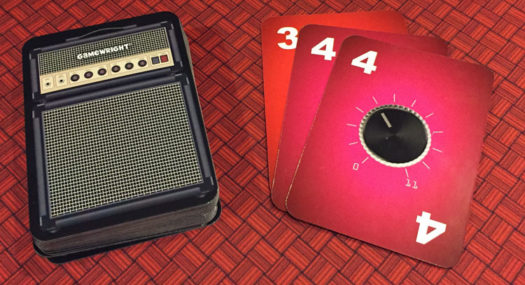
This Game Goes to Eleven can be a great game for young players. Not only does it help kids learn addition in a fun way, but they also get to learn a little strategy as they consider when to play their special cards (0 and 11). Do they save their 0 card to be able to block when someone plays an 11 and tries to give the card pile to them? Or do they use it to take a pile value back to 0 and thus increase the number of cards that will ultimately be in that pile?
The only downside to this game is that some players may feel picked on when others pass the pile of cards to them. Since players must choose someone to hand the pile of cards to when it hits 11, there is a bit of direct conflict in the game. And there’s also the potential that someone may feel ganged up on if players keep dishing all the cards to them (or what feels like all the cards).
Of course, when playing with both kids and parents, the parents will most likely get the brunt of the cards from the kids.
If you’re looking for a quick game that also teaches a bit of simple math, check out This Game Goes to Eleven.
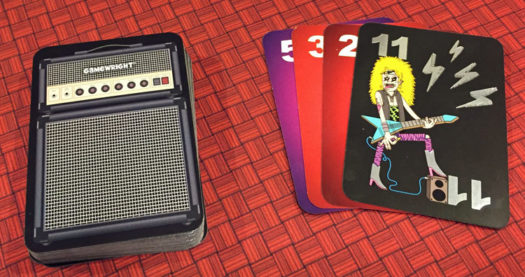
Make 7
Do you remember playing Connect 4? It’s a game that was first released more than 40 years ago where players try to be the first to get 4 of their colors in a row – horizontally, vertically, or diagonally. The fun of the game is that it’s played vertically with players dropping their pieces into columns.
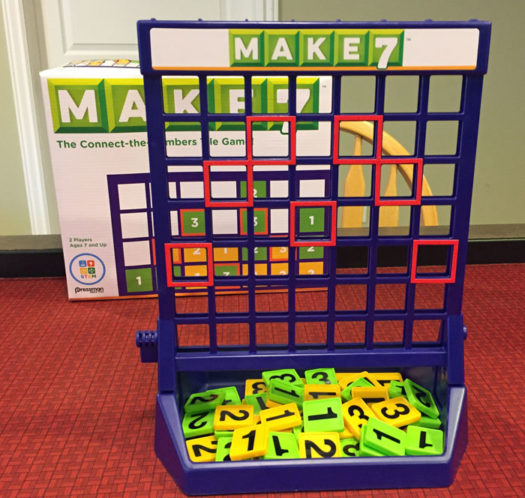
When you first look at Make 7, by Pressman Toys, you may think you’re about to play Connect 4. The game area is a vertical wall with slots where players place their plastic pieces to let them fall into place. Each player has their own colored plastic pieces which they’re trying to get into horizontal, vertical, or diagonal lines.
However, there’s more to the game than just getting colored pieces in lines.
As the name implies, in Make 7 two players go head to head to get their pieces to add up to 7 in a line to win.
That’s because the pieces each player has are values of 1, 2, or 3. Not only do players need to choose where to place their pieces, but they also must plan out how they’ll add up to 7.
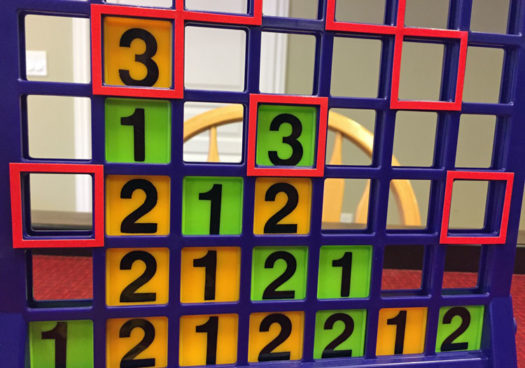
Like Connect 4, it’s a very simple game for kids to understand and play. And because it’s so quick, they’ll want to play over an over.
But the beauty of Make 7 is that there’s another level of thinking required. In addition to the rules I’ve already described, there’s another twist. The value 3 pieces can only be played in the squares marked with the red borders. The other pieces (1 & 2) can also be played in those spaces, but those are the only spaces where 3’s can be played.
Since the value 3 pieces can be so valuable in jumping to 7, they’re limited in where they can be played. So players need to plan around those location limitations as well.
Make 7 can be a great introductory board game for young players with developing minds around strategy, spacial recognition, and simple math.
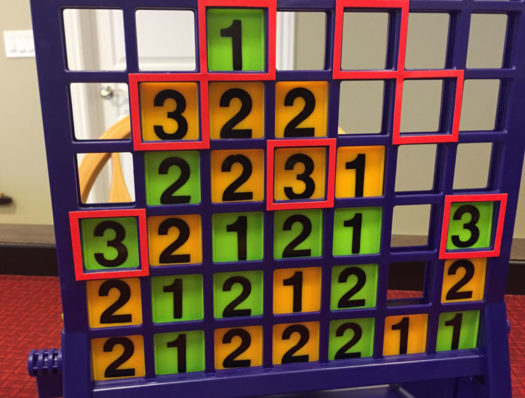
Game Giveaway Cometh
With 3 games down, we’re well on our way to sharing you 7 kids game reviews in 7 days. We’ll split the remaining 4 kids games into 2 posts.
Keep an eye out for our next kids games review posts this week because we’ll wrap up with a kids board game giveaway!
If you don’t want to miss our coming posts, make sure to subscribe so you’ll get notified when the game giveaway is ready to roll.



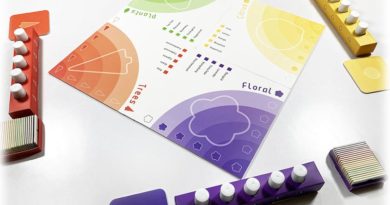
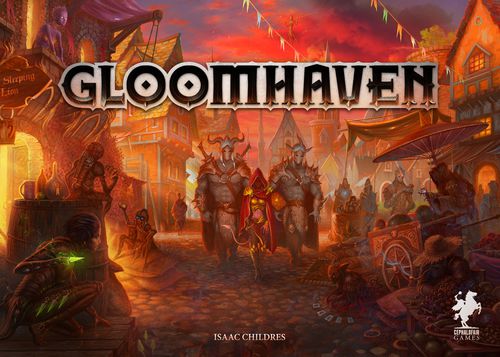
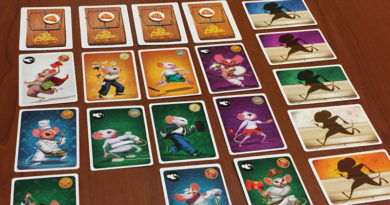
My kids are a bit older now (the youngest is 14) but I could still see us having fun with these.
I was intrigued when I heard there was a “monster cereal” game coming out. It sounds like silly fun. It certainly sounds light (as I would have expected) but still with some interesting choices to make. I’ll have to give it a try.
My daughter might be interested in the other two as well. She loves playing quick card games and she’s a sucker for old classics like Connect 4. The math idea might put her off at first but (thankfully) it sounds like these games are fun rather than being “math for math’s sake.” I might also try using these games with one of the kids I tutor from time to time. I’ve had him do math drills on the computer sometimes but these games may be more fun.
Thanks for the reviews.
Okie – I’ve actually been surprised that our 15 year old keeps beating me at Make 7. It’s so simple, yet somehow he regularly gets the upper hand.
These games look like fun! My son loves math.
My 6-year-old would absolutely love Make 7. He’s at a stage where he loves being quizzed on simple math, so that seems like a winner. What a cool concept. Thanks for pointing it out!
Ryan – I also just checked out your site and like the topics you cover. Keep up the great work!